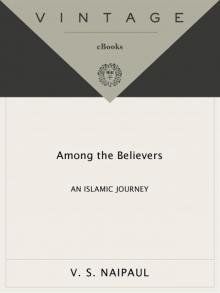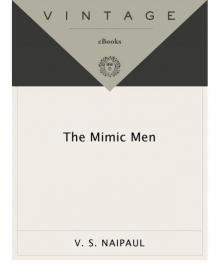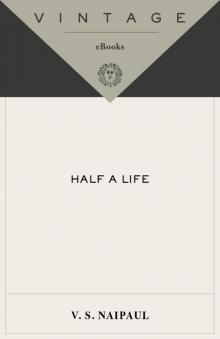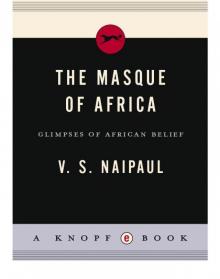- Home
- V. S. Naipaul
A Way in the World Page 2
A Way in the World Read online
Page 2
He knew he was a Mohammedan, in spite of the picture of Christ in his bedroom. But he would have had almost no idea of where he or his ancestors had come from. He wouldn’t have guessed that the name Side might have been a version of Say ed, and that his grandfather or great-grandfather might have come from a Shia Muslim group in India. From Lucknow, perhaps; there was even a street in St. James called Lucknow Street. All Leonard Side would have known of himself and his ancestors would have been what he had awakened to in his mother’s house in St. James. In that he was like the rest of us.
With learning now I can tell you more or less how we all came to be where we were. I can tell you that the Amerindian name for that land of St. James would have been Cumucurapo, which the early travellers from Europe turned to Conquerabo or Conquerabia. I can look at the vegetation and tell you what was there when Columbus came and what was imported later. I can reconstruct the plantations that were laid out on that area of St. James. The recorded history of the place is short, three centuries of depopulation followed by two centuries of resettlement. The documents of the resettlement are available in the city, in the Registrar-General’s Office. While the documents last we can hunt up the story of every strip of occupied land.
I can give you that historical bird’s eye view. But I cannot really explain the mystery of Leonard Side’s inheritance. Most of us know the parents or grandparents we come from. But we go back and back, forever; we go back all of us to the very beginning; in our blood and bone and brain we carry the memories of thousands of beings. I might say that an ancestor of Leonard Side’s came from the dancing groups of Lucknow, the lewd men who painted their faces and tried to live like women. But that would only be a fragment of his inheritance, a fragment of the truth. We cannot understand all the traits we have inherited. Sometimes we can be strangers to ourselves.
CHAPTER 2
History:
A Smell of
Fish Glue
ON MY seventeenth birthday I became an acting second-class clerk in the Registrar-General’s Department. It was a filling-in job, between leaving school and going away to England, to the university; and it was one of the most hopeful times in my life. The Registrar-General’s Department was in the Red House, in St. Vincent Street. This was one of the first streets I had got to know in Port of Spain.
I was a country boy, and still am in my heart of hearts. Only a country boy could have loved the town as I did when I came to it. This was in 1938 or 1939. I loved everything about the town that was not like the country. I liked the paved cambered streets and even the open kerbside gutters: every morning, after they had done their sweeping and gathering, the street-cleaners opened the water hydrants and flooded the gutters with fresh, clear water. I liked the pavements. Many of the houses had decorative fences of a particular style, with a big carriage or cart-gate at the side, usually of corrugated iron, and an elegant small gate in the middle, leading to the front door. These front gates were of stiff patterned wire within a tubular frame and with a metal arabesque at the top. Sometimes they had a bell. I liked the way the pavements dipped outside the big side gates (to let in the carts or cars to the yards, though very few people had cars). I liked the street lamps; the squares with their trees and paved paths and benches; the routine of the town day, from the street-cleaners’ brooms in the early morning, to the newspaper being thrown onto the front steps, to the horse-drawn ice-cart in the middle of the morning. Port of Spain was small, really, with less than a hundred thousand people. But to me it was a big town, and quite complete.
My father was my guide to the city in the very early days. One Sunday afternoon he took me to the city centre and walked me down two or three of the principal streets. Sunday was such a quiet day that you could—for the sake of doing something unusual—get off the pavement and walk in the street itself. Frederick Street was the street of the big stores. More interesting to me was St. Vincent Street. At the lower end, near the harbour, it was the street of the newspapers, the Trinidad Guardian and the Port of Spain Gazette, facing one another. My father worked for the Guardian. It was the more important and more modern paper. From the pavement you could see the new machines, the big rollers, the big unwinding ribbons of newsprint, and you could get the warm smell of machines and paper and printing ink. So, almost as soon as I had come to the city, this new excitement, of paper and ink and urgent printing, was given to me.
Later I got to know the higher or upper parts of the street. The tailor who made trousers for me had his shop in St. Vincent Street. My father took me there one day. The tailor’s name was Nazaralli Baksh. His shop faced west and was shaded from the afternoon sun by a white canvas blind hanging vertically over the pavement. His name was painted on this blind. He was a small, slender Indian man, standing some way inside his shop, perhaps because of the sun. He had a fined-down face, with dark shining eyes set in darker sockets, and with his thin hair brushed back flat: a severe man, friendly to my father, but more matter of fact with me than I expected adults to be. I expected adults who had been properly introduced to me to be a little awed by me, and my “brightness.” The thin tape measure hanging round Nazaralli Baksh’s neck was like part of the severity of his appearance.
I don’t know how good his tailoring was; but this introduction made him the man I thought of as “the tailor.” I thought of no one else as a tailor in quite this way; every other tailor in Port of Spain seemed to me counterfeit. I understood at some stage that he was a Mohammedan. This didn’t at first make him less close; but then, with Indian independence, and the religious partition of the sub-continent, the idea of difference began to attach to him, though I never stopped going to him for my clothes. It was Nazaralli Baksh who made the clothes I took with me when I went away to England.
I heard later that a lot of his work was for the local police force; he made uniforms for them. For us who were his fellow Indians this would have been part of Nazaralli Baksh’s legend and success. Police Headquarters was just across the road from his shop. It was an important Port of Spain building. It was distinctive, with a high grey wall of stone and rubble. Later knowledge told me that it was a British colonial building in the Victorian Gothic style. At the time that rough grey front wall and those pointed reddish arches in the open galleries at the back seemed to be just what you would expect to find in Police Headquarters.
A small town, a small street; but it took time to know. I had no interest in the law or lawyers, for instance, and for many years I paid no attention to that part of the street, opposite the courts, where the lawyers were. Then one day I went to the “chambers”—quaint word—of a famous black lawyer.
This happened quite late, shortly after I had left school. I had been successful at school; it was known—people took an interest in these things—that I had won a scholarship and was going to go abroad soon. The lawyer’s son had been right through school with me, and one day he said he wanted to take me to meet his father. We went to his father’s chambers. These chambers were in St. Vincent Street and occupied the whole of a very small house, a real Port of Spain miniature from the Spanish time. It would have been one of the earliest residential houses, built perhaps in the 1780s, not long after the city had been laid out. I suppose a number of these early houses were as small and squashed as they were because only short stretches of the streets had been made up; bush and plantations would have been quite close.
The little front room of the chambers was full of black people, ordinary people, sitting very close together on two benches, bench facing bench across bare floorboards. The slats of the jalousies of the little front window were coated with dust from the street; you could see on the distempered walls where over the years the people on the benches had rested shoulders and heads. The people I saw were as silent and patient as people waiting for free medicine in a Health Office. Bright eyes, shining faces, reverential expressions: black people coming to one of their own, not minding the discomfort and the stillness and the wait, and not resenting the young boy
who, just arrived, simply went into the inner room where the great man was. The atmosphere of the narrow little waiting room was new to me.
In the more open, cooler room at the back the lawyer was in shirtsleeves, with his lawyer’s jacket on a hanger. The lawbooks and old folders with old papers, the general scruffiness of the chambers, the worm-eaten boards of the partition, made the lawyer’s profession seem a very dull one: it was hard to imagine that anything done in this room could generate real money.
I didn’t know what to say to the lawyer, after the courtesies, which went on for a while. And he seemed equally at a loss; he seemed content just to look at me. I myself had a wish to look below the desk at the lawyer’s shoes. His son had told me, years and years before, when we were both in the fourth or fifth standard at the elementary school, that you could always tell a gentleman by the way he kept his shoes.
My friend didn’t help with the conversation. His manner had altered in the inner office. He had become very much the son, the family treasure, the person who didn’t have to try. He seemed now to be more interested in finding a cold drink. He was very casual with the great lawyer.
The lawyer was famous for his first name, which was Evander. And all I could think of, at this artificial moment, was to ask how he had been given it.
He said, “My father worshipped education. It was his way of giving me ambition. He was not an educated man. But he was born in 1867 or 1870. That’s a long time ago for us. If you look it up, you’ll find the name in Homer. Book four or book five.”
It was surprising, that this famous man hadn’t gone into his unusual name, didn’t know that the name came from Latin and Virgil, and had simply tried to bluff me. He was a self-made man. He hadn’t had anything like a formal education; all his energies had gone into his profession and making his way. But this flaw in his character, so casually revealed, was worrying. While I was getting used to that new idea of him, he was taking the conversation, by ways I cannot reconstruct, to something else.
The moment came when he leaned back in his Windsor chair, thrust his big white-sleeved forearm across the table, in a gesture of strength, and said, with a smile, and as a kind of pledge, “The race! The race, man!”
The black race, the African race, the coloured races: I suppose that was what the lawyer meant, and that was why I had been brought to his chambers.
I looked at his son. His face registered nothing, as though he hadn’t heard what his father had said and hadn’t noticed the gesture he had made.
I didn’t believe that, didn’t believe that blank face. At the lower end of St. Vincent Street I had years before smelt paper and ink and warm printing presses, and certain fantasies had come to me. In this back room of the chambers, with the jalousie-strained light, were other fantasies, subterranean emotions that had to be hidden from the light of St. Vincent Street, from the colonial reality of that street.
This was in the late 1940s. Few black people at that time could see a way ahead. How strange, then, to find an old man, a man born in the last century, to whom the way ahead was clear, something he could even toast, with an instinctive gesture across the desk that twenty years later might have been seen as a black-power salute. What was stranger was that the public idea of Evander, my friend’s father, was not like this at all. In the gossip Evander was the self-made black man who wanted only to be white, wanted to have nothing to do with black people, and in everything he did was fighting only for himself.
This other dream was like a family secret, which father and son were now admitting me to. I was moved, but at the same time embarrassed. I understood their feelings, shared them to some extent, but I wished, even with that understanding, to belong to myself. I couldn’t support the idea of being part of a group. I would have felt tied down by it, and I thought Evander’s idea of a great racial movement forward too sentimental.
THE CIVIL service didn’t employ anyone under seventeen, and in the next year, on my seventeenth birthday, I went to work in the Registrar-General’s Department, and got to know St. Vincent Street in quite another way.
The department was on the ground floor of the Red House. The Red House was the principal building of the administration. It was one of the biggest buildings in the island and we all thought it was beautiful. I am not sure whether its dull red colour came from paint or from something that had been mixed into the plaster. It was one of the buildings that made Port of Spain Port of Spain. You saw it from the harbour, from the hills, and from across the Savannah.
It was in the Italian style, we were told. It was on two floors, with open galleries on both floors, and with a dome. It was as wide as a block, and there was a walkway, below that red dome, between St. Vincent Street and Woodford Square, on the other side. That walkway gave a special big-town feel. You went up stone steps, and then you walked in an echoing openness past a fountain and then down other steps to the other side. The fountain didn’t work—one of the interruptions we associated with the war—but the marble, though iron-stained and tide-marked, was still beautiful, and the idea of the fountain was somehow still there.
On either side of the empty fountain big, free-standing, wooden notice-boards, head-high, were set in front of the open doors of government departments. These notice-boards also served as screens, shielding clerks and typists and other civil servants from the gaze of the people passing to and fro. At the back of the notice-boards were bicycle-racks, where the civil servants chained up their bicycles. Notice-boards and bicycle-racks took away something of the openness of the walkway below the high pierced dome. So already there was a feeling of a fine building not being seen in all its beauty, and beginning to be misused.
The notice-boards didn’t carry government instructions. The pinned-up posters were about health care and the importance of vaccinations, things like that. Many of them came from London, and didn’t always completely apply to local conditions; but we were used to that. These notice-boards and posters were the work of the Information Office, a department that had been established during the war—in a timber building set down on the lawn of the Red House—to give out pictures and booklets about the war and about life in England. These posters and notices about health and blood-tests and X-rays and clean water were a peacetime continuation of that work. You saw these posters only in the Red House; you didn’t see them anywhere else. I never thought they meant anything; but they introduced me to the idea of government as a benevolent agency, concerned about people.
This idea of government shouldn’t have been new to me, after all that I had learned at school. But in every practical and concrete way it was new. It must have been that I carried in my blood and brain very old Indian ideas about the indifference or the arbitrariness of rulers and governments. They were simply there; you looked to them for nothing. Or it might have been that—without any words being spoken—I had grown up thinking of cruelty as something always in the background. There was an ancient, or not-so-ancient, cruelty in the language of the streets: casual threats, man to man and parents to children, of punishments and degradation that took you back to plantation times. There was the cruelty of extended-family life; the cruelty of the elementary school, the bad beatings by teachers, the bloody end-of-term fights between boys; the cruelty of the Indian countryside and the African town. The simplest things around us held memories of cruelty.
The Registrar-General’s Department was to the right of the fountain, if you entered the Red House from St. Vincent Street. If you walked right through you ended in Woodford Square. This was the most beautiful square in Port of Spain, and it was named after the very young English governor who in the second decade of the nineteenth century brought order and law to the colony after the anarchy that followed the British conquest. The Spaniards lost Port of Spain almost as soon as they had laid it out. Woodford Square, at that time, would have been nothing, empty ground. It had been embellished by the British, and we thought it of a piece with the splendour of the Red House. It had a bandstand, a fountain like th
e one in the Red House, benches, decorative iron rails, paved paths; and it was full now of old, shady trees.
Always beautiful, always a glorious thing of the town, yet even when I had first seen it, that Sunday before the war when my father took me on a walk through the town centre, this square was one of the places in Port of Spain where homeless people lived. Most of these people were Indians. Many of them would have been indentured immigrants from India who had served out their indentures on the sugar estates and then for one reason or another—perhaps they had become drinkers; perhaps they hadn’t been given their promised passage back to India; perhaps they had quarrelled with their families—had found themselves with nowhere to live. These people were without money, job, without anything like a family, without the English language; without any kind of representation. They were utterly destitute. They were people who had been, as in a fairy story, lifted up from the peasantry of India and set down thousands of miles away—weeks and weeks of sailing—in Trinidad. In the colonial setting of Trinidad, where rights were limited, you could have done anything with these people; and they were tormented by the people of the town.
We all lived easily with this kind of cruelty. We saw it, but we seldom thought about it. Eventually these people from India died out; by the late 1940s they would nearly all have died. In the early 1940s my father talked to some of them and wrote an article about them for a local Indian magazine. When I went to work in the Red House they were no longer there in Woodford Square. What I remember were the black madmen, two or three of them, one of them with tangled long plaits or tails of stiff hair, grey-brown with dirt and dust and oil, and wearing a Robinson Crusoe-like set of clothes, an accumulation or improvisation not of skins but of rags that had all lost their original colour and turned black and greasy. Perhaps he was harmless; but he had the madman’s assurance, and people walking through the square kept away from where he was, and tried to avoid his bright, inward-seeing eyes.

 The Masque of Africa: Glimpses of African Belief
The Masque of Africa: Glimpses of African Belief A Turn in the South
A Turn in the South An Area of Darkness
An Area of Darkness Literary Occasions: Essays
Literary Occasions: Essays A Way in the World
A Way in the World Among the Believers: An Islamic Journey
Among the Believers: An Islamic Journey A Writer's People: Ways of Looking and Feeling
A Writer's People: Ways of Looking and Feeling The Mimic Men: A Novel
The Mimic Men: A Novel Collected Short Fiction
Collected Short Fiction India: A Million Mutinies Now
India: A Million Mutinies Now In a Free State
In a Free State Half a Life
Half a Life Beyond Belief: Islamic Excursions Among the Converted Peoples
Beyond Belief: Islamic Excursions Among the Converted Peoples Guerrillas
Guerrillas A House for Mr. Biswas
A House for Mr. Biswas The Writer and the World: Essays
The Writer and the World: Essays Magic Seeds
Magic Seeds The Mystic Masseur
The Mystic Masseur Miguel Street
Miguel Street The Return of Eva Perón, With the Killings in Trinidad
The Return of Eva Perón, With the Killings in Trinidad The Middle Passage
The Middle Passage A Bend in the River
A Bend in the River A Turn in the South (Vintage International)
A Turn in the South (Vintage International) Among the Believers
Among the Believers Literary Occasions
Literary Occasions The Mimic Men
The Mimic Men The Writer and the World
The Writer and the World The Masque of Africa
The Masque of Africa